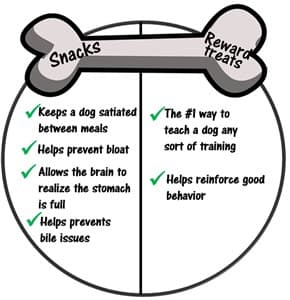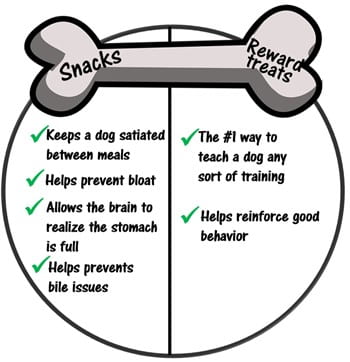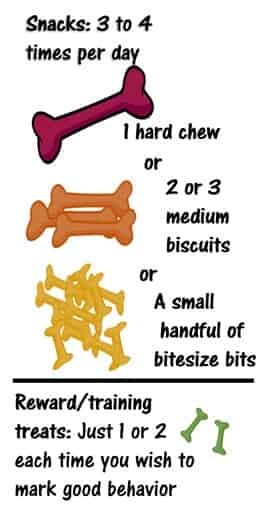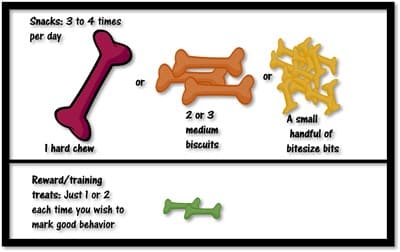Best Snacks for a Pug
Overview
Just as much thought should go into what you give your Pug for snacks and treats as it does in regard to main meals. These can account for 10 to 30% of a dog's daily calorie intake and as with anything that a Pug consumes, will either be detrimental or beneficial.
When you look at the overall nutritional needs for this breed, as well as the importance of steering clear of additives that can cause allergic reactions, upset stomach and other issues, and weight gain being a common issue for adult Pugs, what you offer for snacks and treats will play a huge role in your Pug's overall health and well-being.
This section will cover if snacks are really required, how often they should be given, the difference between snacks and training treats, how to get the most benefits from these, and some healthy and delicious options.
Please note: PetPugDog is reader-supported, and some of the product suggestions on this page may be affiliate links. As an Amazon Associate we earn from qualifying purchases. This is at no extra cost to you and helps keep this site running.
Already know the details of why, how many, and how often and just want recommendations?
Jump to: The Best Snacks for a Pug.
Does a Pug Really Need Snacks and Treats?
You may be wondering if it's just fine to only give your Pug 2 or 3 meals per day without anything extra and if it's really necessary for a Pug to have any snacks or additional treats. And, if your Pug is on a diet to control their weight, this may be particularly relevant.
The short answer is yes, most Pugs can benefit from both snacks and training treats, including those on a weight maintenance plan. Let's look at the advantages of each of these:
Snacks:
- Snacks help satiate a dog's appetite in between meals.
- Without these, a Pug can end up so hungry at meal time that he eats much too fast. Rapid ingestion of food is linked to gastric dilatation volvulus (commonly referred to as bloat) which is a dangerous and often fatal twisting of the stomach.
- It takes about 15 to 20 minutes for the brain to realize that the stomach is full. If a Pug is so hungry that he wolfs down his food, he may want to keep eating even after he's had enough.
- If a dog's stomach is empty for too long of a time, churning stomach bile can cause an upset stomach, as well as cause vomiting of the bile (often appears as a white or yellow foam-type substance).
Training treats:
- The #1 method of teaching a dog what is right and what is wrong is to reward good behavior.
- While praise and petting play a role, a tasty tidbit of food is the most effective way to offer rewards.
- Giving a Pug reward treats can greatly boost your success for housebreaking, command training, efforts to stop barking, jumping up, or chewing on non-toy objects, and works well for the reinforcement of good behavior such as socializing with other dogs or with people.
So, as you can see, giving snacks and treats to your Pug is important. The key is to find a good balance, only offering these tidbits at the right times, in the right quantities, and to stick with very healthy options.
How Many Snacks and Treats to Give to a Pug
Snacks
- This includes dry biscuits, hard edible chews, and dental treats.
- Frequency: Most Pugs do best with a total of 3 snacks per day. This can be any combination of snacks, though dental treats are typically reserved to just one per day. One snack is given between breakfast and lunch, one given between lunch and dinner, and one given one to two hours after dinner. If there is another certain time of the day that your Pug gets really hungry but it's not time for a meal, a 4th can be given.
- Serving sizes: One hard chew, 2 to 3 medium-sized biscuits, a small handful of bite-size biscuits, or one dental treat.
Training Treats
- These are moist or chewy small treats.
- Frequency: When any sort of training is beginning, reward is often given to mark each correct behavior. For example, each time a Pug goes to the bathroom in the designated area or each time a Pug obeys the 'sit' command. In some cases, once training is underway and a Pug is getting the hang of things, reward can be given more sporadically. For example, once commands are understood, praise should be given each time a Pug obeys but reward in the form of a treat can be given every 5th or 6th time.
For every behavior that your Pug displays that pleases you, even well-learned actions like sitting nicely while you place a harness on or heeling beside you while being walked, randomly offer reward and praise to show your Pug that you appreciate their actions.
- Serving size: These are designed to be very small to offer just a tiny burst of flavor so that appetite is not affected by multiple rewards. Only one or two small training treats should be given each time you wish to mark good behavior.
The Difference Between Dog Snacks and Dog Training Treats
While technically you can give one in place of the other, there are a few main differences:
Snacks, meant be given to a Pug in between meals should be dry. This is the best consistency to calm down the stomach and keep away hunger pains. These may be labeled as treats or chews often along with the words crunchy or dry, or you may see the terms cookie, cracker, or biscuit. These are often large enough that a dog has to chew at least a few times before swallowing it down. This also includes hard chews meant to be gnawed on for a while for either teething puppies or Pugs that see chewing as an enjoyable hobby.
Training treats, meant to be given to a Pug during training and to mark good behavior should be moist. This is the best consistency to quickly deliver the message that a dog did a great job. These may be labeled as treats, training treats, chews, or training chews and you will usually see the terms moist, soft, or chewy. These are typically very small; they are designed to offer a quick burst of flavor while not having much of an impact on a dog's appetite.
Snacks to Avoid Giving a Pug
Before we dive into the best options for snacks to give to a Pug, there are 3 types that should be avoided:
1. Rawhides. This pose a risk to all just about every dog breed. Most are made from the inner layers of cow or horse hides and then artificially flavored. Dangers of these types of snacks include choking, contamination of E. Coli or salmonella, digestive problems including stomach and intestinal distress and/or diarrhea, and internal blockage which is considered an emergency and can be fatal.
2. Pig ears. The shards from these dry brittle snacks can cause tooth breakage and cause injury to the throat. Once swallowed, improperly chewed pig ears can cause blockage to the intestinal tract.
3. Real animal bones. It is not safe to give a Pug real bones from ham, chicken, turkey, duck, beef roast or any other meat. Cooked bones are the biggest danger, though raw bones can cause problems as well. Cooked bones become very brittle and can crack into sharp splinters that pierce the mouth, throat, stomach, or intestinal tract causing choking, blockage or internal injury. Raw bones are a bit safer but still pose risks including splinters and over consumption of marrow that can lead to diarrhea (and flare ups for dogs prone to pancreatitis).
The Best Snacks for a Pug
Avoid:
Whenever you are giving your Pug any sort of food, it is just as important to be aware of which ingredients need to be avoided as it is to what is being offered. Issues seen with these sorts of ingredients and additives range from allergic reaction (itching, rash, hives, and/or breathing issues) to upset stomach, and with some, long term consumption is linked to disease including certain cancers. Ingredients to steer clear of include:
- Synthetic preservatives.
- Artificial coloring or flavoring.
- Soy, corn, and high levels of wheat
- By-products
- Generic meats or oils
- Made overseas, particularly China
Look for:
Choose snacks that are preserved using a vitamin blend (will show as mixed tocopherols), with only natural flavors and wholesome ingredients such as real meat (including fish, chicken, turkey, bison, salmon, and lamb), fruits (including apple, blueberry, strawberry, melon, pumpkin, cranberry, and banana), vegetables (including carrots and sweet potatoes), and/or other healthy ingredients including yogurt, cheese, and peanut butter. And, as we covered, these should be dry (not moist).
Recommended:
There are some great options:
1. Fruitables Pumpkin Baked Crunchy Dog Treats . This is a line of super-healthy 100% all-natural treats and these particular ones have a great crunch to them. There are so many awesome flavors including those with yogurt or a beef base, and this one is a variety pack that pairs pumpkin with apple, banana, blueberry, and cranberry. It's a great way to give a Pug different flavors, each is only 9 calories, and these are made in the USA.
. This is a line of super-healthy 100% all-natural treats and these particular ones have a great crunch to them. There are so many awesome flavors including those with yogurt or a beef base, and this one is a variety pack that pairs pumpkin with apple, banana, blueberry, and cranberry. It's a great way to give a Pug different flavors, each is only 9 calories, and these are made in the USA.
2. Bandit's Biscuits All-Natural Cookies . These are good-sized crunchy wafer cookies that are also 100% all-natural. There are 3 delicious recipes: peanut butter, blueberry, and cheese & bacon. These have no corn, wheat, or soy, have just 10 calories per cookie, and are made in the USA.
. These are good-sized crunchy wafer cookies that are also 100% all-natural. There are 3 delicious recipes: peanut butter, blueberry, and cheese & bacon. These have no corn, wheat, or soy, have just 10 calories per cookie, and are made in the USA.
3. Old Mother Hubbard Classic Crunchy Natural Treats . This is a fantastic option for helping a Pug stay happy until the next meal. These are dry baked biscuits made in North America (the US and Canada) with lots of yummy flavors to choose from. There are veggie biscuits with carrots, sweet potatoes, and apples and there's also liver, bacon & cheese, and peanut butter to name a few. Note that some of these recipes have flour or some grains but there is also a grain-free option if you prefer that for your Pug. The small size works for most adult Pugs and mini size is best for most Pug puppies.
. This is a fantastic option for helping a Pug stay happy until the next meal. These are dry baked biscuits made in North America (the US and Canada) with lots of yummy flavors to choose from. There are veggie biscuits with carrots, sweet potatoes, and apples and there's also liver, bacon & cheese, and peanut butter to name a few. Note that some of these recipes have flour or some grains but there is also a grain-free option if you prefer that for your Pug. The small size works for most adult Pugs and mini size is best for most Pug puppies.
4. Sam's Yams Veggie Rawhide Sweet Potato Treats . Though 'rawhide' is in the name, that is just their way of letting you know that these chews are a great alternative to real rawhides (which as we covered are dangerous) for dogs that like to chew. These are designed for small and medium sized breeds, like the Pug, and literally have just one ingredient: healthy sweet potatoes. These are good for a dog's teeth, which is always a plus and these are made in the USA.
. Though 'rawhide' is in the name, that is just their way of letting you know that these chews are a great alternative to real rawhides (which as we covered are dangerous) for dogs that like to chew. These are designed for small and medium sized breeds, like the Pug, and literally have just one ingredient: healthy sweet potatoes. These are good for a dog's teeth, which is always a plus and these are made in the USA.
The Best Training Treats for a Pug
Avoid:
Just like snacks, training treats should not have synthetic preservatives, artificial coloring or flavoring, soy, corn, high levels of wheat, by-products, generic meats or oils, or be made overseas (particularly China).
Since these are meant to offer just a small yet powerful burst of flavor to mark good behavior and help with training, avoid anything that is large enough that your Pug has to chew more than just a few times.
Look for:
Treats that use a vitamin blend as a preservative (mixed tocopherols). These should have a strong flavor that dogs see as high-value including meats like bacon, lamb, and bison and sweet fruits like watermelon, apple, and berries.
Recommended:
Here are a few that are healthy for Pugs and extra tasty:
1. Fruitables Skinny Minis . Though all the entire line of Fruitables are pretty low in calories, the ones in this line have just 2 or 3 calories per treat which make these a great choice for adult Pugs that need an eye kept on their weight and are the perfect chewy consistency for giving rewards. This is a variety pack with apple & bacon, pumpkin & berry, and pumpkin & mango. These are all-natural and are made in the USA.
. Though all the entire line of Fruitables are pretty low in calories, the ones in this line have just 2 or 3 calories per treat which make these a great choice for adult Pugs that need an eye kept on their weight and are the perfect chewy consistency for giving rewards. This is a variety pack with apple & bacon, pumpkin & berry, and pumpkin & mango. These are all-natural and are made in the USA.
2. Wellness Natural WellBites Soft Treats . Wellness does a fantastic job with both kibble and treats; there is no grain, soy, corn, by-products, or other additives and all are preserved with vitamins. And, these are made in the USA.
. Wellness does a fantastic job with both kibble and treats; there is no grain, soy, corn, by-products, or other additives and all are preserved with vitamins. And, these are made in the USA.
These little square training treats are ideal because you can break these in half if you're doing a session that involves lots of action rewards, like heeling or working on a command or offer one square for one-time action rewards like house training. There are lots of yummy recipes to choose from for these treats including turkey & duck, beef & turkey, chicken & lamb, and lamb & salmon.
3. Zuke's Mini Naturals Dog Treats .These are fantastic training treats for Pugs in that they are a great size for giving multiple times, have just 3 calories per piece, and come in a wide range of flavors that dogs love including chicken, duck, rabbit, peanut butter & oats, and salmon. There is no corn, soy, or wheat, these are made in the USA, and a citrus and vitamin blend is used as a natural preservative.
.These are fantastic training treats for Pugs in that they are a great size for giving multiple times, have just 3 calories per piece, and come in a wide range of flavors that dogs love including chicken, duck, rabbit, peanut butter & oats, and salmon. There is no corn, soy, or wheat, these are made in the USA, and a citrus and vitamin blend is used as a natural preservative.
Giving Fruits and Vegetables as Snacks
There are some crunchy vegetables and soft fruits that you can give to a Pug, if you wish.
Veggies - Not every dog will be thrilled to be given plain veggies, but some do like to chew on raw baby carrots which are good for the teeth. Other vegetables that a Pug can eat include peas, green beans, potato, sweet potato, spinach, and kale, but these are best mixed into meals.
Fruits - Many fruits have good levels of fiber that cause natural sugar to be absorbed slowly, so fruit can be given in moderation. Fruits that Pugs can eat include pear, banana, blueberries, raspberries, and mango. On hot summer days, berries can first be frozen which can make a nice, cool treat.
And Don't Forget About Dental Treats
Taking good care of your Pug's teeth is a vital part of care and dental chews are edible so these should be looked at as necessary snacks.
One of the most preventable issues that happens to dogs is dental decay and periodontal disease. Just like humans, plaque is constantly being produced. If it is not removed, it starts to harden into tartar in as little as 3 days. Plaque and tartar both form hard coatings on the teeth, often moving below the gum line, and eating away at enamel. Decay develops and this is a silent destruction that can lead to infections and tooth loss.
You can help prevent this by performing at home dental care of your Pug's teeth
via brushing them or using a spray and by offering a daily dental chew. This will take the place of one of your Pug's regular snacks that is given in between meals or as an after dinner snack. Note that some dental chews are very tasty so a dog will accept these as they do any other yummy treat.
Also please note that these have a very hard texture (they must, to do their job) and for that reason a dog should be supervised when chewing on these.
One of the most popular ones is GREENIES Dental Chews
 which come in a range of sizes, based on a dog's weight. The teenie size is for dogs 5 to 15 lbs. and the petite size is for dogs 15 to 25 lbs. If your Pug is over 25 lbs., this is most likely due to carrying a few extra pounds, and not a natural large body structure, so the petite size will still work well in many cases.
which come in a range of sizes, based on a dog's weight. The teenie size is for dogs 5 to 15 lbs. and the petite size is for dogs 15 to 25 lbs. If your Pug is over 25 lbs., this is most likely due to carrying a few extra pounds, and not a natural large body structure, so the petite size will still work well in many cases.
Did you find this article to be helpful?
If so, you'll love PetPugDog's GIANT Book of Pug Care. This huge, comprehensive book is available in both hard copy (soft cover) and PDF ebook.
Want to stay informed?
Become a free PetPugDog Member to receive newsletters that announce new articles and updates.





